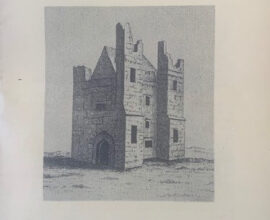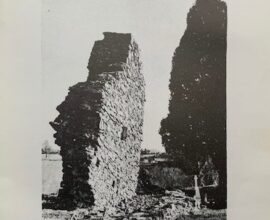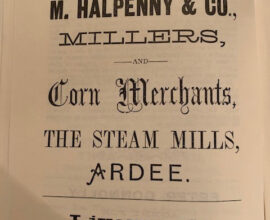Part 1: The Keppock family and Cromwellian Confiscations
by LP Murray, 1933.
The Keppock Family
The Keppocks had an association with Ardee extending over at least three centuries – down to the time of their dispersal during the Cromwellian plantations. Their name still survives in the townland of Cappock’s Green, and in Cappock’s Gate, both of which are situated at the East of the town. In the Royal Charter of the Corporation of Ardee (AD 1377) we find it ordered that the account for the monies expended on the murage and pavage of the town should be rendered at the end of each year before “Our beloved John Keppock of our Sheriff of Louth.” Portion of the land of Ardee must have been granted to this same John Keppock at some time previous, for, in 1383 we are told that he held from the Kind, per servicium, one messuage, one mill, two carucates and 59 acres of pasture; and that he was granted a license to enfeoff John Strode, John Steward, and John Lovell to himself and his heirs in perpetuum; and that these three may, in turn, enfeoff John Keppock and his wife Alicia. This was evidently a trust – or it may have covered a marriage settlement. John died in 1412, in which year the custody of a small portion of his lands (one messuage and one acre in Ardee, and one acre in Richardstown-White) was granted to Richard Verdon – to hold during the minority of the heir. Six years later, there was a royal grant to Roger Hakenshow, John Taillour and Roger Keppock, of six messuages and 33 acres in Ardee, formerly owned by Richard Burgess.
In 1446 we have a record of a Thomas Keppock, then over eighty years of age, who gave evidence on behalf of the Friars of St John when the Corporation attempted to deprive them of the Glebe of Ardee. He said that he remembered the Monastery to have possession during the government of four priors. He was probably a brother of John – which might go to show a much earlier settlement of the family in Ardee.
One of John’s descendants, William Keppock – probably a grandson of Roger – was portreeve of Ardee in 1519, and again in 1537. He married Janet Babe. Their son, John Keppock, at the time of his death in 1591, was seised of 60 acres in Baltrasna, 120 acres in Ardee, a large house and garden, and a mill and weir known as Keppock’s Mill and Keppock’s Weir – all held directly from the king – together with 15 messuages and 19 gardens outside Kenton’s Gate, held from the Manor of Ardee (Barnewall and Nugent) under the terms of the deed of trust (1383) already referred to. His mother, Janet Babe, who was still alive in 1591 had a life interest in one third of the estate as part of her marriage settlement. Another John succeeded, who was then forty years old and married. His son, Stephen, who followed him died before 1605. Thomas, his heir, was but twelve years old at the time of Stephen’s death. An entry in the Patent Rolls of the year 1605 supplies evidence of the rather peculiar methods of the Court of Wards. Thomas Pudden, gentleman, was granted the wardship of Thomas Keppock, son and heir of Stephen Keppock of Ardee, deceased, for a fine of £2 and an annual rent of £5 retaining £3 10s 3d for his maintenance and education in the English religion and habits, and in Trinity College, Dublin, from the 12th to the 18th year of his age. This attempt to anglicize the boy must have been a failure, for the portions of the Trinity College Depositions which deal with the meeting of the Louth gentlemen at Tullyesker in November 1641 tell us that Thomas Keppock of Ardee was appointed one of the captains to raise troops for the Confederate army. In 1625, Thomas Keppock and his wife, Elinor, sold sixty acres of the lands called Curraghbeg and Curraghmore to Anthony Townley of Collon. Thomas represented Ardee in the Parliament of 1634. He must have died before 1657, as the name of Stephen Keppock appears in the Civil Survey. At the Confiscation, the Keppock lands were divided up amongst Christopher Barnewall (83 acres), Mary and John Foulke (380 acres), the Earl of Carlingford (29 acres) and Richard Hodson (16 acres). The following is a tentative reconstruction of the Keppock family tree:

The Cromwellian Confiscation
In 1641 the Keppock estate contained 509 Irish acres, plantation measure – but it is to be noticed that the Down Survey generally stated the contents as less by about one-seventh than the actual measurement – so that the Keppocks must have owned almost 600 of our modern Irish acres. The estate lay chiefly in Baltrasna, Great Lough (now Broad Lough), Mulladrillen, Rathgory, and the town of Ardee.

It will be seen that the Fowkes got the lions share. As a matter of fact, Barnewell’s 63 acres were merely the portion that the Keppocks had held from the Manor of Ardee; while the Earl of Carlingford’s 29 acres – mostly property in the streets of the town – were a small part of a grant received by that nobleman to compensate him for the Cromwellian confiscation of his Sligo estates. The Fowke grant may easily be identified:

This is sufficiently close to Fowke’s grant of 380 acres to make the identification certain. The three extra acres were added to Dawson’s Demesne about the year 1754. A corn mill is also referred to in the Cromwellian Grant – probably the one known in later days as Hale’s Mill.
The Family of Fowke
The original grantee – John Fowke of Drogheda – died between 1657 and 1666. He was apparently a Cromwellian adventurer who, in addition to an immense grant of 1300 acres scattered through the townlands of Boolies, Cookstown, Cappocke, Lawlerstown, Dromin, Panstown, Hacklem, and Millockstown, received also 375 ac of lands of Ardee with a corn mill, a castle, six acres of gardens and several tenements. His son, John (junior) did not long survive, and the owners living in 1666 when the grant was confirmed by the Act of Settlement, were John Fowke (the third) and his mother Mary. The following genealogical table will help to explain the position:

In 1669, after the death of John Fowke, junior, we find Mrs Southwell and her husband taking an action against Mary Fowke (widow) and John Fowke (the third) to recover Alice Southwell’s (nee Fowke’s) dower. She was granted a yearly income of £45, with two preliminary grants of £160 and £140 respectively.
John Fowke (the third) had evidently only one daughter, Mary, who inherited the whole property. She married Henry Tichbourne of Beaulieu, and survived him. Their son was the first Baron Ferrard, but his title died with him.
The Tisdalls
On December 23, 1709, the above mentioned Mary Tichbourne sold for ever, to Richard Tisdall of Dublin for a consideration of £4600, all her Co Louth property, the lands of Boolies, Lawlerstown, Dromin and Knockdinny, Painstown, etc and the lands in Atherdee and several tenements and gardens. The Castle is not mentioned in the deed of sale, but probably was included.
In 1726 Richard Tisdall mortgaged the town and lands of Broadlough to William Hamiltom, surgeon, for a loan of £2000. Hamilton proceeded to foreclose in 1734, but evidently died before doing so. His widow, Elizabeth Hamilton, by direction of Richard Tisdall, assigned the mortgage to Philip Tisdall for a consideration not stated. In 1742, the said Philip Tisdall, Sergeant-at-Law, for a consideration of £6730 8s 9d, sold to Alderman Richard Dawson of the City of Dublin the lands of Boolies (90 acres), part of the lands of Ardee (375 acres, 1 road with corn mill), commonly called by the names of Broadlough, Baltrasny, Mullaghdrislen, the Mansion House, garden outhouses, demesne lands, the upper avenue, Kappock’s Mill etc. – subject to a yearly ground rent of £1 16s 6d out of Boolies and £7 11s 7d out of Ardee.




